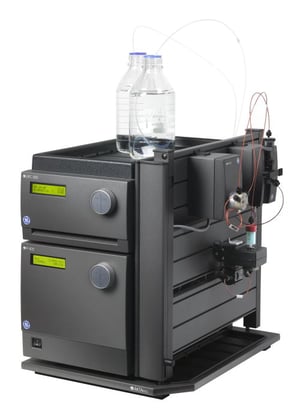 Many researchers use high pressure liquid chromatography (HPLC) to separate and measure concentrations of small molecules. However, this method is relatively ineffective when trying to extract proteins and other biochemicals. Organic solvents used in HPLC place restrictions on these biochemicals, which are unable to function at high temperatures. For this reason, in 1982, Pharmacia developed fast protein liquid chromatography (FPLC) to overcome the weaknesses of the HPLC and institute an effective, quick means to extract and purify biochemicals - especially proteins.
Many researchers use high pressure liquid chromatography (HPLC) to separate and measure concentrations of small molecules. However, this method is relatively ineffective when trying to extract proteins and other biochemicals. Organic solvents used in HPLC place restrictions on these biochemicals, which are unable to function at high temperatures. For this reason, in 1982, Pharmacia developed fast protein liquid chromatography (FPLC) to overcome the weaknesses of the HPLC and institute an effective, quick means to extract and purify biochemicals - especially proteins.
How does FPLC chromatography work?
FLPC falls into the category of medium-pressure chromatography, and typically includes the following:
- Pump
- UV Detector
- Conductivity meter
- Fraction collector
- Most offer a computer software interface for configuration and method creation
As is typical in a liquid chromatography, FPLC includes a solid or liquid stationary phase (typically a resin) and a liquid mobile phase. A pump is used in the FPLC to manipulate and maintain the flow of the mobile phase. Various proportions of fluids can be used to form the eluent, and when the composition of the eluent differentiates, the absorption rate from component to component varies. When done properly, FPLC chromatography separates proteins and peptides in the sample. Using conductivity, the FPLC measures salt concentration, as well as the protein concentration by absorption of UV light at a wavelength of 280 nm.
The software interface for FPLC controls modules and enters purified samples into the fraction collector, and indicates pH and conductivity of the components.
What are the main differences between FPLC and HPLC?
There are a number of procedural and equipment requirement differences between HPLC and FPLC. One important note to consider is that in FPLC chromatography, the mobile phase is associated with salt buffers, as opposed to the solvents in the mobile phase of HPLC. Purification in FPLC consists of several varying methods (consider affinity, gel-filtration, ion exchange, and various others) and is, thus, a more complex process. Additionally, FPLC flow rate capabilities are significantly higher than flow rate capabilities of HPLC (more than 10 times higher) and have much lower back pressure capability.
Both HPLC and FPLC use resins in the stationary phase; HPLC resins consist of silica beads that can withstand much higher pressures than FPLC resins, which often consist of polymer materials and agarose.
HPLC vs. FPLC: Which should I use?
Both of these chromatology methods are fairly similar, but there are some important distinctions, as described below.
Use the FPLC for the following reasons:
- Need a preparative technique (not an analytical technique)
- Use of biochemicals and organic chemicals with high peptide and protein concentrations (such as plasma, urine, and cerebrospinal fluid)
- Measure using pH and conductivity of components
- Commonly used as a purification technique
HPLC is best for these situations:
- Need an analytical technique (not a preparative technique)
- Need to do qualitative and quantitative analysis
- Use of small, molecular, non-organic chemicals
Rely on G-Biosciences for All Your Protein Purification Needs
At G-Biosciences, we offer a selection of products for protein purification. Browse through our products and then contact us with any questions or to place an order.






